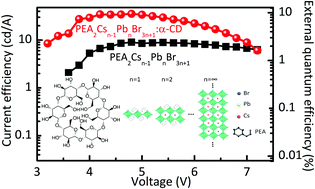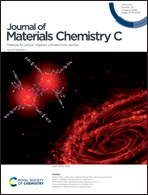Efficient quasi-two dimensional perovskite light-emitting diodes using a cage-type additive†
Abstract
Quasi-two-dimensional (quasi-2D) perovskite semiconductors have great advantages in perovskite light-emitting diodes (PeLEDs). However, the overall electroluminescence (EL) performance of quasi-2D PeLEDs is mainly determined by the properties of quasi-2D perovskite films. Therefore, in this work, α-cyclodextrin (α-CD) with a cage-type structure as an additive is blended with quasi-2D perovskite semiconductors to control their morphologies and optoelectronic properties. It has been demonstrated that this cage-type additive not only improves the morphologies but also suppresses non-radiative recombination for quasi-2D perovskite semiconductors. As a result, the EL performance of α-CD-assisted PeLEDs has been greatly improved. The maximum current efficiency (CE) and external quantum efficiency (EQE) of PeLEDs with α-CD modification are 28.4 cd A−1 and 7.4%, respectively, which are 3.2-fold those of the control PeLEDs (without α-CD modification). The half-life of PeLEDs is 329 s under an initial luminance of 1000 cd m−2. Finally, the CE and EQE of PeLEDs with α-CD modification can be further improved, up to 35.5 cd A−1 and 9.2%, respectively, by utilizing poly(9,9-dioctyl-flurene-co-N-(4-butyphenyl)-diphenylamine) (TFB)/poly(9-vinylcarbazole) (PVK) as the hole transport layer (HTL) for enhancing the hole transport and balancing the hole/electron injection.



 Please wait while we load your content...
Please wait while we load your content...